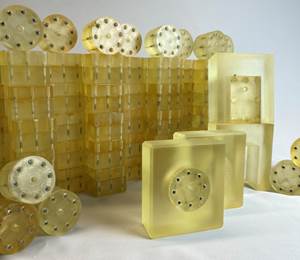Ove Nielsen: A Standing Ovation!
This SPI Moldmaker of the Year 2005 honoree’s diligent work for the industry has spanned two continents.
A native of Denmark, Ove Nielsen started his long and illustrious moldmaking career more than 40 years ago overseas before embarking on a trip to the U.S. that would lead to a permanent move and many years of contributions to the moldmaking industry—helping him to win the Moldmaker of the Year 2005 Award from SPE Mold Making and Mold Design Division (see 2006 Award Candidates sidebar).
Currently the Tooling Manager for Tuthill Plastics Group in Clearwater, FL—a custom plastic injection molder—he has designed molds for small electronic parts, music cassettes, personal care products and CDs over the years. His accomplishments include conducting research for the government on new methods of mold building technology for the Bradley tank; research on how to mold a stress-free part; work on the orientation of very long glass fiber-filled materials for even distribution; and work on molds for thin wall parts, perfecting the flow of material, and managing stress and flow lines.
From Europe to America
Born in Denmark 65 years ago, Nielsen attended and graduated from high school in his native country before entering a four-year apprenticeship program. He began work for ESSO Plastics building blow molds before opportunity knocked from abroad. He packed his bags and he and his wife moved to Long Island, NY, where Nielsen began work for Swingline—a leading manufacturer of staplers. He began working in their R&D department with engineers on prototyping technology. However, his employment there was short-lived as he found his business philosophies did not mesh with management. After six weeks, he moved to New Jersey and briefly left the industry he was growing to love—accepting a position with Litton Electronics (Orange) in their R&D department.
After nine months, Nielsen grew restless and longed to get back into the moldmaking industry. He began networking and soon got offered a job at Whalite Manufacturing (Montville, NJ)—a small electronic component manufacturer with compression and injection molding operations. During the two years he spent there, he worked on molds and inserts for small electronic parts. Then, he made a move to Master Tool and Mold (Hanover, NJ)—a builder of plastic injection and rubber molds—to run their tooling department for a decade. There were only six employees when he started, which eventually rose to 16 under Nielsen’s tutelage. “We built tools for a company called Joyce Molding (Rockaway, NJ), which manufactured music and video cassettes,” Nielsen says. “Joyce expressed an interest in Master Tool and Mold as they wanted to expand their operations, so the president sold Joyce Molding the company, and I went with them to start their toolroom.”
Nielsen spent 13 years with Joyce Molding—introducing the company to the latest technologies and taking it to the next level by using the latest tool steels in innovative ways. “I had a friend working for Uddeholm, and I called him up and told him I wanted to try working with some newer materials in different applications,” Nielsen explains. “We got together and—by choosing the appropriate tool steel for our application—we started building tools capable of molding two parts in the same cavity. This was risky back then, but the owner allowed us to go ahead with it.”
At the time, Joyce Molding was cultivating a relationship with leading personal care product manufacturer Mennen. According to Nielsen, their tool was old and beat-up, and they told Nielsen if he could get it to run, Joyce Molding would get their business. “We did just that—eliminating the flash by plating the mold with silver,” he notes. “We then ended up doing between $5 and 7 billion per year just for Mennen, eventually rebuilding all of their tools.”
Nielsen also played a vital role in Joyce Molding establishing global operations. They opened a facility in Denmark—with Nielsen traveling back and forth every few months overseeing the engineering department. The company also added molds for CD boxes to its repertoire and as a result, sales grew from $2 million to $40 million a year. “It was a very aggressive company,” Nielsen says. “I really enjoyed it as they were never afraid to do anything. They kept on top of all of the latest technology and didn’t sit back and wait for business to come to them—they always took the first step. The presses ran 24/7; we never stopped except at Christmas. Otherwise, we just ran through all of the holidays.”
Making A Change
Nielsen then decided to take his career in a new direction. He was offered a job at the Stevens Institute of Technology (Hoboken, NJ) in the mechanical and chemical engineering departments—once again in R&D. He did research for the government—specifically on new materials for tanks and missiles “The government wanted to replace the steel with plastic to bring the weight down and increase the tank’s speed,” Nielsen elaborates. The government put an end to the program before Nielsen’s work was completed. His research on molding a stress free part was never applied to an actual working mold because of the long cycle times involved in the heating and cooling processes. This work—along with his studies of how fibers were orientated inside plastic and examining material flow—was passed along to the school’s professors so they could report on Nielsen’s findings. “It was a very impressive place,” he notes. “I was surrounded by very knowledgeable people and I really enjoyed the work.”
After five years with Stevens Institute, Nielsen made the decision to retire and move to Florida with his wife. One of his former coworkers from Joyce Molding worked at Tuthill Plastics Group, found out Nielsen was in the area and paid him a visit. “He told me the company needed me,” Nielsen recalls. “And I was never one to turn away from a challenge.” Today, he runs the company’s day-to-day operations—including working with the mold shops Tuthill outsources its molds to. Once again he is doing work for the government on components for a “smart” bullet that is under development to eventually replace hand grenades. He is not permitted to elaborate on the details except to say the bullet contains a computer chip inside that can be programmed to pinpoint a target that is behind walls, trees, etc., and it is “very challenging” due to the tight tolerances required. The project is in the solid modeling and flow analysis phases.
“I thought I was done when we moved to Florida,” Nielsen notes. “Here I am eight years later! I’d like to keep working as long as possible. I just couldn’t stay home every day. I have really enjoyed my years in the moldmaking industry.”
Related Content
In "Hybrid" FIM Process, 3D Printing Complements Injection Molding
Alpine Advanced Materials used a desktop 3D printer and the freeform injection molding process to reduce prototype tooling production time and cost for its customers.
Read MoreHow to Clean and Maintain Molds With Intricate Conformal Cooling Channels
A water-based, eco-friendly plastic mold cleaning system helps Rankine-Hinman Manufacturing restore flow rates and avoid big-ticket failures on complex and costly molds.
Read MoreTrue Five-Axis Machine Yields More Throughput, Greater Productivity
CDM Tool & Mfg. Co. LLC increased shop capacity thanks to a versatile high-speed/high-accuracy five-axis Fooke mill capable of cutting very large workpieces quickly and accurately with fewer setups.
Read MoreCT Scanning Helps Micro Molder Reduce Cost of First Article Inspections
CT scanning services performed by 3D ProScan, a division of NyproMold Inc. provides MTD Micro Molding with accurate, high-resolution internal and external measurements performed about seven times faster and at significant cost savings.
Read MoreRead Next
Fred Steil: SPE's 2004 Moldmaker of the Year
Accolades abound from the Society of Plastics Engineers for this industry veteran who has spent his life giving back to the industry.
Read MoreHow to Use Continuing Education to Remain Competitive in Moldmaking
Continued training helps moldmakers make tooling decisions and properly use the latest cutting tool to efficiently machine high-quality molds.
Read MoreHow to Use Strategic Planning Tools, Data to Manage the Human Side of Business
Q&A with Marion Wells, MMT EAB member and founder of Human Asset Management.
Read More




















